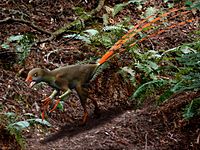| Newly named mammals |
|---|
| Name | Status | Authors | Age | Unit | Location | Notes | Images |
|---|
Albireo savagei [112] | Valid | | Late Pliocene | Pismo Formation | | A member of Delphinoidea belonging to the family Albireonidae, a species of Albireo. |
Cantalera [113] | Valid | - Badiola
- Canudo
- Cuenca-Bescós
| Early Cretaceous (late Hauterivian-early Barremian) | | | A multituberculate belonging to the family Pinheirodontidae. The type species is C. abadi. |
Crenatocetus [114] | Valid | | Eocene | | | A member of Protocetidae. The type species is Crenatocetus rayi. |
Cynarctoides whistleri [115] | Valid | | Hemingfordian | | | A member of Canidae belonging to the subfamily Borophaginae, a species of Cynarctoides . |
Diceratherium radtkei [116] | Valid | | Arikareean | Cabbage Patch beds
Harrison Formation
Sharps Formation | | |
Djourabus [117] | Valid | | Late Miocene | | | A member of Mustelidae belonging to the subfamily Lutrinae. The type species is D. dabba. |
Floridameryx [118] | Valid | | Late Miocene to earliest Pliocene | | | A member of Gelocidae belonging to the subfamily Pseudoceratinae. The type species is F. floridanus; genus also includes "Pseudoceras" klausi Frick (1937). |
Fossendorhinus [119] | Valid | | Uintan | | | A member of Brontotheriidae; a new genus for "Telmatherium" diploconus Osborn (1895) |
Fredszalaya [120] | Valid | | Late Oligocene | | | A member of Borhyaenidae. The type species is Fredszalaya hunteri. |
Glibia namibiesis [121] | Valid | - Pickford
- Senut
- Morales
- Mein
- Sanchez
| Eocene (Lutetian) | | | A rodent belonging to the family Zegdoumyidae, a species of Glibia . |
Merycopotamus thachangensis [122] | Valid | - Hanta
- Ratanasthien
- Kunimatsu
- Saegusa
- Nakaya
- Nagaoka
- Jintasakul
| Late Miocene | | | |
Metalopex [123] | Valid | | Late Clarendonian to early Hemphillian | Ash Hollow Formation
Kern River Formation
Rattlesnake Formation
Thousand Creek Formation | | A fox. The type species is Metalopex merriami. |
Mioheteromys crowderensis [124] | Valid | | Late Hemingfordian to Barstovian | Barstow Formation
Crowder Formation | | A rodent belonging to the family Heteromyidae, a species of Mioheteromys . |
Namahyrax [121] | Valid | - Pickford
- Senut
- Morales
- Mein
- Sanchez
| Eocene (Lutetian) | | | A hyrax. The type species is Namahyrax corvus. |
Namaia [121] | Valid | - Pickford
- Senut
- Morales
- Mein
- Sanchez
| Eocene (Lutetian) | | | Probably a member of the family Adapidae. [125] The type species is Namaia bogenfelsi. The generic name turned out to be preoccupied; Pickford and Uhen (2014) created a replacement name Notnamaia. [126] |
Namalestes [121] | Valid | - Pickford
- Senut
- Morales
- Mein
- Sanchez
| Eocene (Lutetian) | | | A member of Cimolesta belonging to the family Todralestidae. The type species is Namalestes gheerbranti. |
Namatherium [121] | Valid | - Pickford
- Senut
- Morales
- Mein
- Sanchez
| Eocene (Lutetian) | | | An embrithopod. The type species is Namatherium blackcrowense. |
Nasamplus [119] | Valid | | Late Eocene (Ulangochuian) | | | A member of Brontotheriidae; a new genus for "Metatitan" progressus Granger and Gregory (1943). |
Pollyosbornia [119] | Valid | | Uintan | Uinta Formation | | A member of Brontotheriidae; a new genus for "Telmatherium" altidens Osborn (1908). |
Prepomonomys [121] | Valid | - Pickford
- Senut
- Morales
- Mein
- Sanchez
| Eocene (Lutetian) | | | A rodent belonging to the family Diamantomyidae. The type species is Prepomonomys bogenfelsi. |
Proadinotherium saltoni [120] | Valid | | Late Oligocene | | | A member of Toxodontidae, a species of Proadinotherium. |
Siamoadapis [127] | Valid | - Chaimanee
- Yamee
- Tian
- Chavasseau
- Jaeger
| Middle Miocene | | | | |
Silicamys [121] | Valid | - Pickford
- Senut
- Morales
- Mein
- Sanchez
| Eocene (Lutetian) | | | A rodent belonging to the family Myophiomyidae. The type species is Silicamys cingulatus. |
Sivaonyx beyi [117] | Valid | | Late Miocene | | | A member of Mustelidae belonging to the subfamily Lutrinae. |
Stenomylus taylori [128] | Valid | | Miocene (Hemingfordian) | Zia Formation | | A camelid. |
Teilhardina magnoliana [129] | Valid | | Early Eocene | Tuscahoma Formation | | |
Wickia [119] | Valid | | Uintan | Sand Wash Basin
Washakie Formation | | A member of Brontotheriidae. The type species is Wickia brevirhinus. |
|























